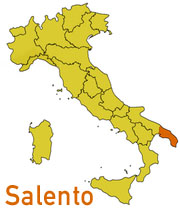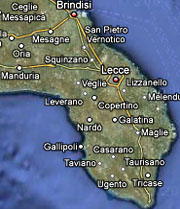Salento – the Geographical location
Salento is the name of a 100 km long and 40 km wide peninsula in the extreme southeast of Italy and is often referred to as “heel” of the Italian “boot”. Administratively the peninsula is part of the Apulia region and includes the province of Lecce and part of the provinces of Taranto and Brindisi. The area is sometimes referred to as Terra d’Otranto.
The most important towns of the Salento are
Lecce, Brindisi, Taranto, Gallipoli, Otranto, Maglie, Galatina and Nardò.
Marina di Novaglie
here you find a very good link to Novaglie, with description and pictures
Story
From prehistoric times dolmens and menhirs have been preserved as remains of early farming-culture. In ancient times the area was inhabited by the Messapi, an Illyrian tribe that had to defend its independence in wars against the Greek colony Taras (Taranto). Herodotus tells of a war around the year 474 v. Chr. Between Taras and the Lega peuceta (an alliance in the area around Bari), which was supported by the Lega Messapica (from Salento). In this conflict, the Messapians could after several years of war still keep the upper hand, from about 280 v. Chr. However the Roman republic in Southern Italy gained for supremacy.
Lecce had its economic and artistic heyday between 1550 and 1750. At that time the city of Lecce also received its present characteristic-baroque appearance. You can admire numerous buildings of typical Lecce Baroque style. The Roman amphitheater was exposed at the time of Mussolini partially, with valuable older buildings were demolished. 1955 State University of Lecce (now University of Salento) was founded.
Language and culture
The Italian dialect which is spoken in Salento, is completely different from those dialects that are spoken in the rest of Puglia.
There are also some Greek linguistic enclaves which are probably caused by a medieval migration or are even created by the ancient Greek immigration. The “Grecia Salentina” includes towns like Corigliano, Melpigniano, Castrignano dei Greci, Martano, Calimera and other villages.
In architecture, the Salento differs from the rest of Apulia. Traditional houses are built in Greek style, i.e. they are often whitewashed and have a flat roof. The historic city centers, however, are mainly built in the Baroque style, with some typical Salentine details like the exuberant facade painting of palazzi and churches. Pietra Leccese was the most popular building-material, a rock with a warm reddish-yellow color, but also the yellow Carparo.
For the rest of Apulia typical historic architectural style is predominantly Romanesque unlike Salento.
Location in Italy


Click on the map to see a more detailed view.
Lecce
Region: Apulia
Lecce (LE)
Height: 49 m s.l.m.
Area: 238 km²
Population: 96,000 (2011), of which 53% women
Population density: 400 inhabitants / km².
Demonym: Leccesi
Patron: Sant’Oronzo, San Giusto and San Fortunato
Lecce (from the Latin: Lupiae) is a city in Apulia and the capital of the province of Lecce, in Salento.
In the countryside of Lecce a relatively soft, yellowish / reddish tuff “Carparo” and the slightly harder yellowish limestone “Pietra Leccese” is used, which made possible the rapid spread of the Salentine Baroque, whose numerous buildings can be admired in the city center. Because of the city’s Barocco-Leccese it has also been called the “Florence of the South”. One of the most famous examples of the Baroque style of Lecce is the facade of the Basilica of Santa Croce.
Lecce History
The foundation extends to the year 1211 BC. And Malemnius is attributed, the son of Dasumnus, the first king of the Salentines. Next the legend, the city was occupied after the destruction of Troy by Lictius Idomeneus, who is said to have given it its name and opened the Greek culture. The origin of the city of Lecce is shrouded in darkness. Even less is known about the period from the 4th to the 11th century. It was a time of fighting, looting, exploitation; one of the bleakest of the Middle Ages.
Their heyday, the city, however, in the late Middle Ages. Lecce then belonged to the county Enghien and awoke slowly to new life after relegation, which they had fallen prey to the downfall of the Western Roman Empire and during the following years. The lively cultural life that prevailed in the city has always been, you have been named “Athens of Puglia” a. Although the achievements of the modern era shut by no means, but it has retained its original appearance; at first glance it can be seen that art has in Lecce deeply rooted.
Transportation and roads
Lecce is very easily accessible by the Italian Railway from Milan via Bologna, Rimini and Ancona Bari, or from Rome via Naples and Bari. The nearest airport is located about 60 km away in Brindisi, north of Lecce. By car Lecce can be reached via the well-developed and toll-free motorway SS 16 (E 55) from Bari via Brindisi. The urban core of Lecce is surrounded by a ring of 7 km in diameter, so that the narrow streets in the inner area are hardly burdened with through traffic.
There are many direct flights to Brindisi, from all major towns of Europe: London, Paris, Berlin, Zurich, Brussels and many more.
Website of the airport Aeroporto di Brindisi
National train connections Trenitalia FS
Local trains Ferrovie del Sud Est
Local bus lines Bus del Salento
Destination Salento
The Salento peninsula has only lately been discovered by tourism. In Santa Cesarea Terme has beatiful villas and a palace in oriental style, a sense of “1001 Nights”. In the coast some thermal sulphurous mineral springs gushing out of caves. At the Cape Santa Maria di Leuca situated on the southernmost point of Puglia, a place of pilgrimage; here is a pilgrimage monastery. Gallípoli on the west coast of the peninsula has a unique location on an island. Otranto is the eastern port of Italy and always an important bridgehead on the Adriatic. The historic town is perched on a rock, in the north bordering on wide sandy beaches and pine forests. The interior of the peninsula is characterized by extensive olive groves which form veritable forests and partly are many centuries old. These millions of olive trees provide the “gold of Puglia” a qualitatively very high standing olive oil, which has been exported for centuries, into the wide world. The soil is very fertile and climatic factors givel 3 harvests per year on the same field.